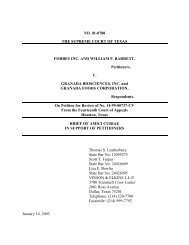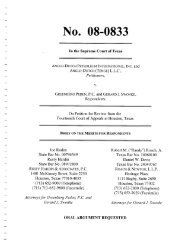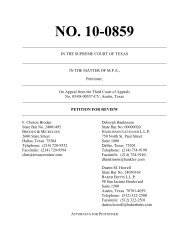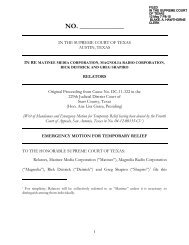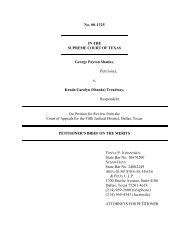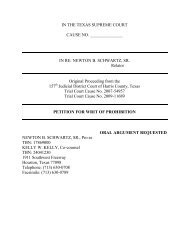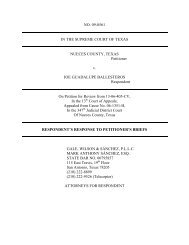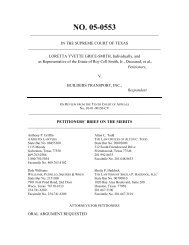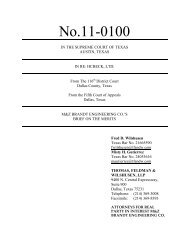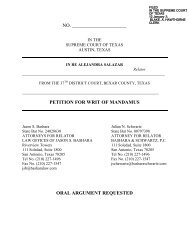DAIMLERCHRYSLER CORPORATION, Petitioner - Supreme Court ...
DAIMLERCHRYSLER CORPORATION, Petitioner - Supreme Court ...
DAIMLERCHRYSLER CORPORATION, Petitioner - Supreme Court ...
You also want an ePaper? Increase the reach of your titles
YUMPU automatically turns print PDFs into web optimized ePapers that Google loves.
460 (D.N.J. 1998); see, e.g., Garza, 2005 Tex. App. LEXIS 532, at *I9 (“For purchasers who never experienced a<br />
problem during the time they owned the car, they got what they paid for - a vehicle that provided transportations<br />
with a brake system that safely stopped the car.”); Wallis v. Ford Motor Co., No. CV-2002-154-2, slip op. at 1-2<br />
(Ark. Cir. Ct. Jan. 15, 2004) (dismissing fraud and consumer protection act claim based on an “allegedly<br />
unreasonable tendency to roll over” because “plaintiff has not experienced a cognizable injury or damages as a result<br />
of the alleged defect”); Accardo v. Bririgesfone-Firestone, Inc., No. 44495, slip op. at 3 (40th Judicial Dist. Ct., St.<br />
John the Baptist Parish, La., Apr. 21, 2004) (dismissing redhibition and unjust enrichment claims based on same<br />
allegations for a lack of any legally cognizable injury); Green v. Gen. Motors Corp., KO. A-2831-01T-5, 2003 WL<br />
21730592, at *6-*9 (N.J. Super. App. Div. July 10, 2003) (barring “no injury” claim under warranty law and<br />
consumer protection act); Frank, 741 N.Y.S.2d at 11, 16 (rejecting claim that vehicle backrests were “susceptible to<br />
rearward collapse” because “it would be manifestly unfair to require a manufacturer to become, in essence, an<br />
indemnifier for a loss that may never occur”); Ziegelmann v. Daimler Chlysler Corp., 649 N.W.2d 556, 565 (N.D.<br />
2002) (complaint alleging defect in vehicle because lack of park-brake interlock device “failed to plead any legally<br />
cognizable injury’’ where “[tlhe gist of [complaint] is that the vehicle might malfunction and cause injury in the<br />
future”); Ford Motor Co. v. Rice, 726 So. 2d 626, 627, 631 (Ala. 1998) (holding that plaintiffs could not pursue<br />
claim for fraudulent suppression involving Bronco I1 vehicles with alleged tendency to roll over where the “alleged<br />
product defect . . . has not manifested itself in such a way as to cause any observable adverse physical or economic<br />
consequences.”); Am. SuzukiMotor Corp. v. Superior <strong>Court</strong>, 37 Cal. App. 4th 1291, 1296 (1995) (where class action<br />
plaintiffs allege that they have suffered no personal injury or propew damage from an allegedly defectively<br />
designed vehicle they cannot state a cause of action for breach of implied warranty); Yu v. IBM Corp., 732 N.E.2d<br />
1173, 1177-78 (Ill. App. Ct. 2000) (dismissing consumer fraud and negligence action due to lack of actual injury or<br />
damages); Capital Holding Corp. v. Bailey, 873 S.W.2d 187, 192 (Ky. 1994) (holding that no cause of action<br />
accrues with respect to defective product “until the potentially harmful [product] actually ‘causes injury that<br />
produces loss or damage”’) (quotations and citation omitted); Spuhl v. Shiley, Inc., 795 S.W.2d 573, 580 (Mo. Ct.<br />
App. 1990) (rejecting failure to warn claims because plaintiff did not allege “failure or malfunction of the product”);<br />
Lavelle v. Owens-Corning Fiberglas Corp., 507 N.E.2d 476, 479 (Ohio Ct. Com. P1. 1987) (barring claim alleging<br />
increased risk of cancer because “the injury, and the damages resulting, must be shown with certainty, and not be<br />
left to speculation or conjecture, whether the action is in contract or tort; damages which are uncertain, speculative,<br />
or conjectural cannot be recovered”) (internal quotation marks and citation omitted); Eriehl v. Gen. Motors Corp.,<br />
172 F.3d 623, 628-29 (8th Cir. 1999) (dismissing plaintiffs’ wide-ranging set of claim (i.e., fraudulent<br />
misrepresentation, fraudulent concealment, breach of implied warranty, state consumer protection statute, breach of<br />
express warranty, and breach of contract) due to no injury); Angus v. Shiley, Inc., 989 F.2d 142, 148 (3d Cir. 1993)<br />
(disallowing no injury claim concerning allegedly defective heart valves because law not intended to “sanction a<br />
large, if not vast, number of lawsuits by consumers who obtained properly functioning valves”); Willett v. Barter<br />
Int’l, Inc., 929 F.2d 1094, 1099-1100 (5th Cir. 1991) (same); Carlson v. Gen. Motors Corp., 883 F.2d 287, 291 (4th<br />
Cir. 1989) (dismissing tort and implied warranty claims by “named plaintiffs who did not allege that they<br />
encountered engine difficulties with their own cars”); Feinstein v. Firestone Tire & Rubber Co., 535 F. Supp. 595<br />
(S.D.N.Y. 1982) (rejecting implied warranty claims asserted on behalf of vehicle owners who had experienced<br />
failure-free performance from their Firestone tires, notwithstanding the claim that tires were inherently defective and<br />
likely to fail); In re Air Bag Prods. Lid Litig., 7 F. Supp. 2d at 804 (dismissing tort and implied warranty claim<br />
brought by putative class alleging defective air bags because “the absence of manifest injury is so fundamental a<br />
deficiency. . . that such claims are more appropriately dismissed than preserved”); Martin v. Ford Motor Co., 914 F.<br />
Supp. 1449, 1454-56 & n.9 (S.D. Tex. 1996) (“[Tlhe manufacture of an unsafe vehicle itself, if such has indeed<br />
occurred, cannot constitute the cause of injury to Plaintiffs [without damage.]”); Weaver v. Chlysler Coi-p., 172<br />
F.R.D. 96, 100 (S.D.N.Y. 1997) (“Where, as here, a product perfom satisfactorily and never exhibits the alleged<br />
defect, no cause of action lies.”); Lee, 950 F. Supp. at 174-75 (rejecting claims that roofs on sport-utility vehicles<br />
were defective where plaintiffs experienced no defects in their vehicles); Hubbard, 1996 WL 274018, at *3<br />
(S.D.N.Y. May 22, 1996) (“[A] Suburban that perfom satisfactorily and never exluhits the alleged braking system<br />
defect is fit for the purposes intended ”); BarbaFin v. Gen. Motors Corp., No. 84-0888, 1993 WL 765821, at *2<br />
(D.D.C. Sept. 22, 1993) (“The court will . . . dismiss the claims of all plaintiffs whose X-cars never experienced the<br />
phenomenon of ‘premature rear wheel lock-up . . . .”’); Yosf v. Gen. Motors Corp., 651 F. Supp. 656 (D.N.J. 1986)<br />
(dismissing complaint for fraud and breach of warranty for failure to state a claim where plaintiff could only allege<br />
that vehicle was likely dangerous).<br />
15




